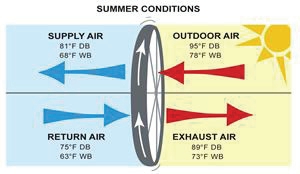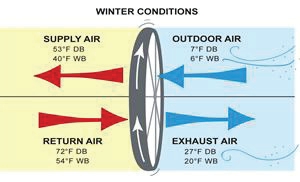An HRV is a heat recovery ventilator and can be used in both the heating and cooling seasons.
An HRV is a sensible-only recovery device. That means it can recover sensible (dry) energy but not latent (moisture) energy. This does make it less effective during the cooling season.
An ERV system is a sensible-plus-latent device. ERV systems provide a controlled way of ventilating a home while minimizing energy loss.
Both HRV's and ERV's include a heat exchanger, one or more fans to push air through the exchanger, some controls and are typically central, whole house ventilation systems with their own duct system or shared ductwork.
Although both HRV's and ERV's capture thermal energy, ERV's transfer a high percentage of the water vapour to the air stream with the least amount of moisture. That means an ERV "kicks out" some of the incoming moisture in summer, keeping your home more comfortable, and retains some humidity in winter, again providing more comfort.
Excessive moisture should be considered a pollutant!
Most energy recovery ventilation systems can recover about 70% to 80% of the energy in the exiting air and deliver that energy to the incoming air. However, they are most cost effective in climates with extreme winters or summers, and where fuel costs are high.
In the summer, an ERV removes the humidity from the incoming outdoor air and shifts it over to the exhaust air, keeping it out of the building, the inside air also cools the warmer supply air to reduce ventilation cooling costs.

In the winter, an ERV removes humidity from the exhaust air and transfers it over to the outdoor ventilation air, eliminating the need for humidifiers, it also reduces the costs of heating ventilated air by transferring heat from the warm inside air being exhausted to the fresh (but cold) supply air.

The graphics above illustrate the impact an ERV has on the temperature of a building's airflow in winter and summer conditions. The DB (dry bulb) measurement indicates the pure air temperature. The WB (wet bulb) measurement indicates the temperature in relation to the humidity level.
Moisture always moves from the air stream that is the most humid to the one that is the driest.
There are essentially four different types of ERV's.
The decision to use an ERV (a sensible-plus-latent device) or an HRV (a sensible-only device) is a matter of psychometrics.
The general guideline for applications for most climate zones is to always use an ERV to get the greatest energy benefit, as well as greatly improve humidity control.
Because ERV's generally cost more than HRV's, the latter are used more often.
For ERV systems simplicity is key to a cost-effective installation. To save on installation costs, many systems share existing ductwork. Ensure the installing HVAC contractor has enough technical expertise and experience to install an ERV. In general, you want to have a supply and return duct for each bedroom and for each common living area. Duct runs should be as short and straight as possible. The correct size duct is necessary to minimize pressure drops in the system and thus improve performance. Insulate ducts located in unheated spaces, and seal all joints.
There are applications where an HRV makes more sense, such as a locker/shower room. In this case, the indoor humidity always is much higher than the outdoor humidity and it is desirable to remove that moisture from the space at all times of the year.
No Utility Bills Inc.
All rights reserved.
Last modified: 03/29/25



